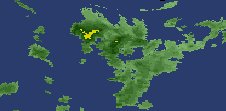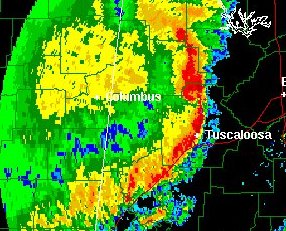
The reflectivity gradient is defined as how much the value of radar reflectivity changes over distance. If the reflectivity changes significantly over a small distance then that would be a strong reflectivity gradient. If the reflectivity changes only slightly over a significant distance then that would be a weak reflectivity gradient. Determining what is a strong gradient, weak gradient or a gradient that is in-between takes practice. With a few examples we will show how each look on radar. First we will look at a commonly used scale for reflectivity values. The scale is shown below:  The green colors represent light reflectivity (light rain aloft), the yellow colors are more of a moderate reflectivity (moderate rain aloft) and the red colors represent heavy reflectivity (heavy rain and possible hail aloft). An example of a strong reflectivity gradient is a red color next to no reflectivity while an example of weak reflectivity would be a gradual transition from green to yellow colors. Below is an example of a weak, moderate and strong reflectivity gradient. WEAK REFLECTIVITY GRADIENT  MODERATE REFLECTIVITY GRADIENT  STRONG REFLECTIVITY GRADIENT  The reflectivity gradient is important because it can give clues to if severe convective wind gusts are occurring. Severe convective wind gusts are more likely to occur when there is a strong reflectivity gradient. The leading edge of severe thunderstorms often have an abrupt transition zone of heavy precipitation and wind. In this region the outflow from the storm is progressing into the environmental air ahead of the storm. Strong convective winds will force the reflectivity into an abrupt zone where the reflectivity changes rapidly over a small distance. Look for severe convective wind gusts when red reflectivity is next to very little or no reflectivity. This is especially true if the storms are in a line segment that is bowing. |